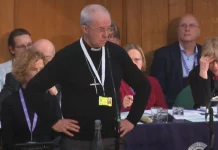OVID was bad for the Church of England. And new data show just how bad. Overall, the church lost one in five of its Sunday worshipers during COVID. For children at worship, it’s worse.
Canterbury Cathedral makes the CofE appear impressive, but appearances can deceive. The Diocese of Canterbury had 1,600 children in Sunday worship in 2019, before COVID. By 2022 it had 1,000 children in Sunday worship. That’s nearly a 40 percent drop.
Long-term decline coupled with COVID has left much of the church in deep trouble. Yes, there are wonderful pockets of vitality, but their number is shrinking. The new data show that, during COVID, the condition of much of the church has moved from serious to critical.
Advertisement
The End of Sunday
The latest C of E data are just out, covering 2022. Here are the overall figures for Sunday attendance in the Church of England since 2000.
Usual Sunday Attendance (all ages)
2000 950,000
2010 799,000
2019 680,000
2022 549,000
Sunday attendance has nearly halved since the millennium. A church that had long been declining has seen the decline dramatically speed up during COVID. The latest data, covering 2022, are crucial because they give us a clear sense for the first time what COVID did to the church. The data from 2020 and 2021 were so affected by COVID they cannot easily be used. By 2022 most churches were doing in-person worship, and those who wished to attend could do so. The evidence is that those who had not come back by 2022 were not going to come back in significant numbers.
Online worship? The figures for this are rightly described as the wild west of ecclesial data-gathering. It is impossible to know exactly what they mean, and church leaders cannot put too much weight on them. The advent of online church has value, but has proved compatible with dramatic congregational decline in the C of E and elsewhere, and there is no reason to think that this will change.
What this Looks Like on the Ground
Here are figures for a handful of dioceses, which give a sense of the effects of such decline on the ground.
Usual Sunday Attendance 1990 2019 2022
Bath and Wells 33.5k 16.9k 14.3k
Manchester 35.1k 18.4k 14.0k
Ely 17.7k 13.6k 11.2k
Southwark 40.5k 31.6k 25.2k
London 51.8k 53.6k 43.4k
You can see the deep fall in Sunday attendance over recent decades and how this sped up since COVID. All dioceses have lost between a fifth and a quarter of their Sunday worshipers, between 2019 and 2022.[i] And this accelerated deep pre-existing decline. Some dioceses, like Bath & Wells and Manchester, have lost 60 percent of their Sunday congregations since 1990. Some, like London and Ely, have done less poorly, but all have seen a sharp drop since 2022.
There are other metrics for measuring attendance. They have their virtues, but also their vices. The great virtue of “usual Sunday attendance” is that it offers a long run of years of data. And it is easy to collect. There are other measures, but they generally offer shorter runs of data and, in some cases, are highly complex to calculate, raising concerns about the reliability of data. And the other metrics support the attendance trends given above.
Here is “leveling down” in action. For several decades, the Diocese of London held out against the rest of the church and actually grew (modestly). At last, it has come back into line. London is now declining as fast as everywhere else. London used to be an embarrassment for many C of E bishops. Why did it keep growing, when every other diocese was shrinking? This is an issue no longer. Every single C of E diocese is shrinking.
Beyond that, there are wider trends. Some of the smaller rural dioceses have shrunk less. But don’t be fooled. This is because they already had a tiny number of children and families. And it is children and families who have been most likely to stop attending during COVID.
The most spectacular falls are in some urban dioceses like Manchester and Liverpool. Both have half the number of Sunday worshipers now, compared to the beginning of this century.
Here’s one intriguing shift: The Diocese in Europe used to be regarded as a minor player in Anglicanism. But, post-COVID, the dioceses of Worcester, Newcastle, Portsmouth, Hereford, Truro, and Carlisle are all smaller than the Diocese in Europe in their Sunday attendance.
The End of Children in the C of E
The data are worse when you look at children. Sunday attendance for children is 23 percent down, overall, between 2019 and 2022.
But the figures in some dioceses were much worse. As noted, the Diocese of Canterbury had 1,600 children in Sunday worship in 2019. By 2022 it had 1,000, nearly a 40 percent drop. Many other dioceses are not far behind. Hereford “only” dropped from 500 to 400 children, across all its churches, 2019-22. Hereford has 399 churches. In 2023, it is likely that Hereford has more church buildings than it has children inside them, on an average Sunday across the entire diocese. Whilst the average fall in English child Sunday attendance is 23 percent, many C of E dioceses lost a significantly larger proportion of children in Sunday worship during COVID.
The bulk of adult believers come to faith in the first decades of life. Things were bad regarding children in worship before COVID. In large swathes of England, the church now has no children in its churches on a Sunday. This is moving beyond decline and toward extinction.
This bleak picture is backed by other figures. Read it all at the Living Church










